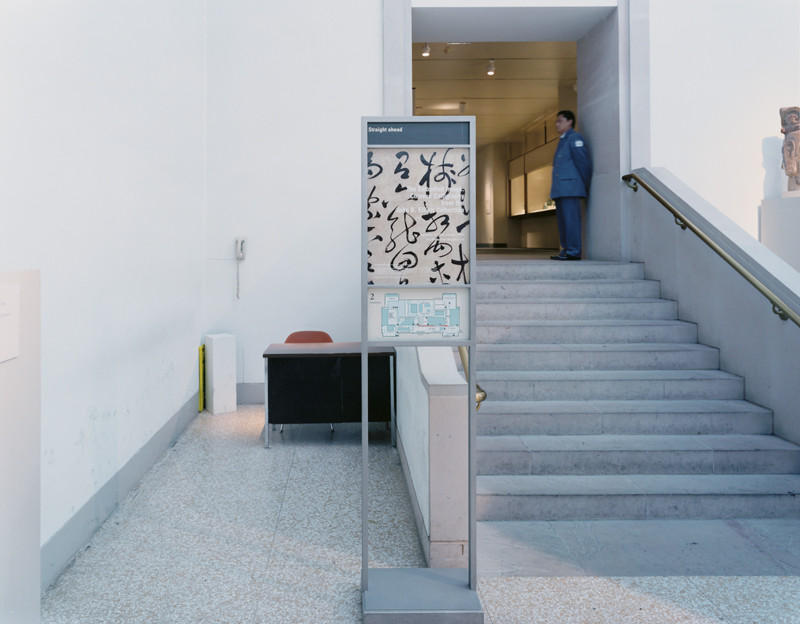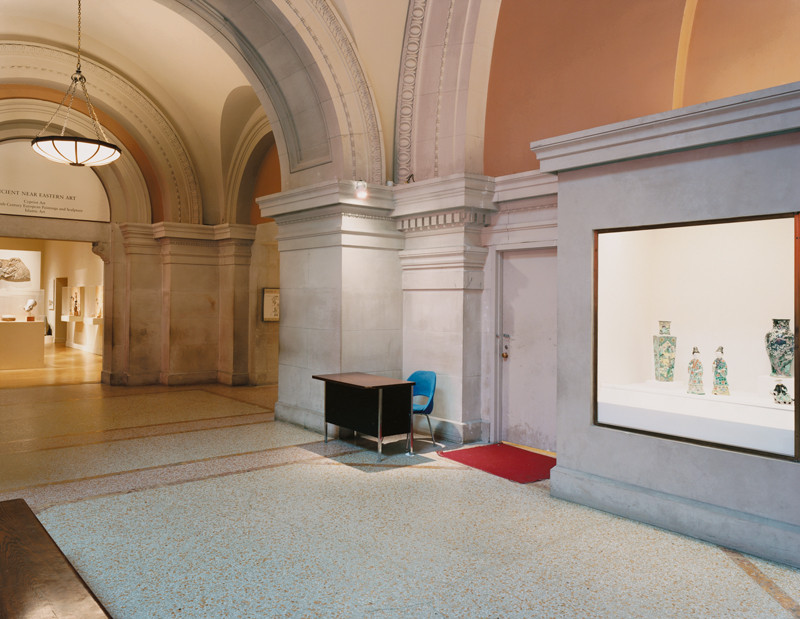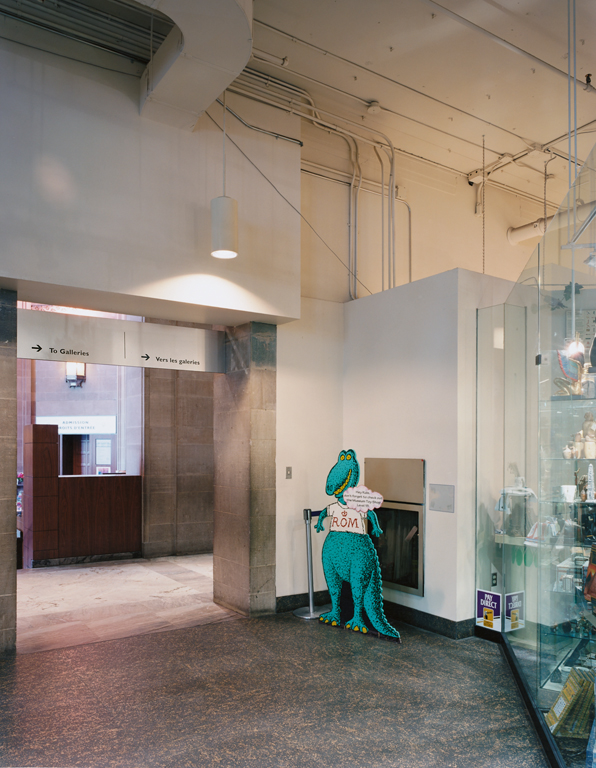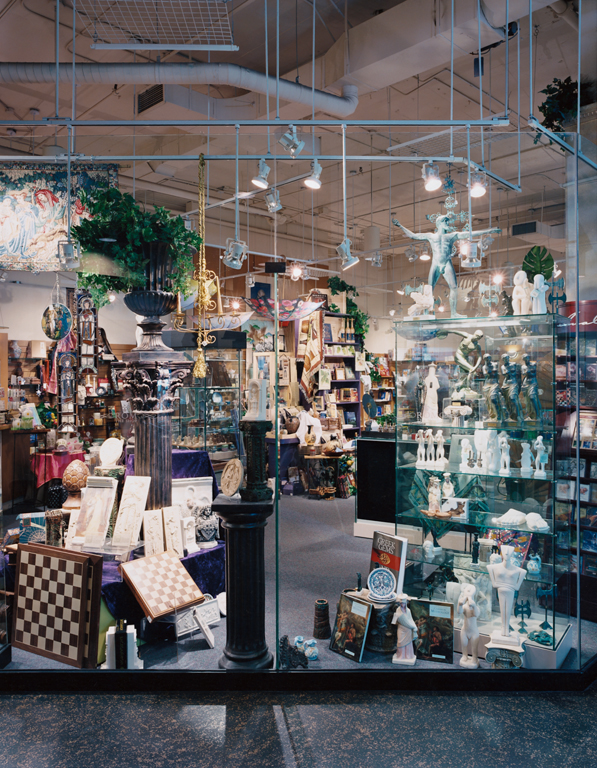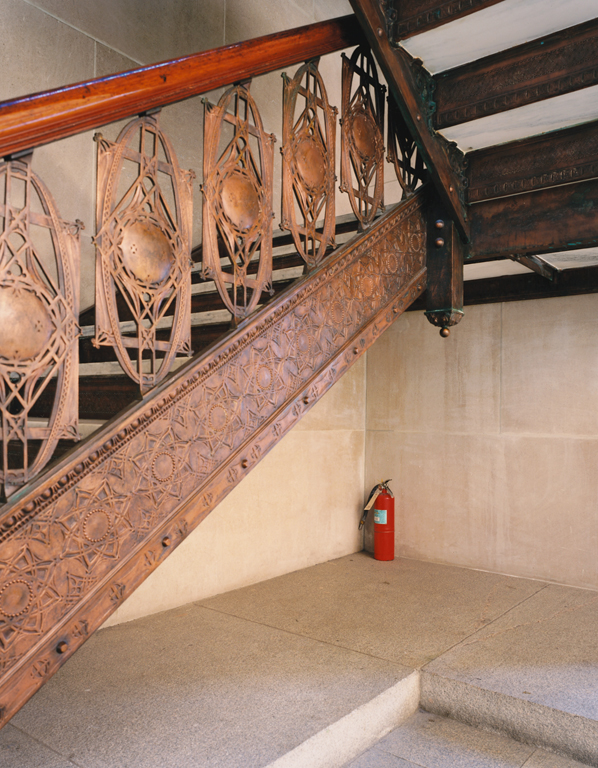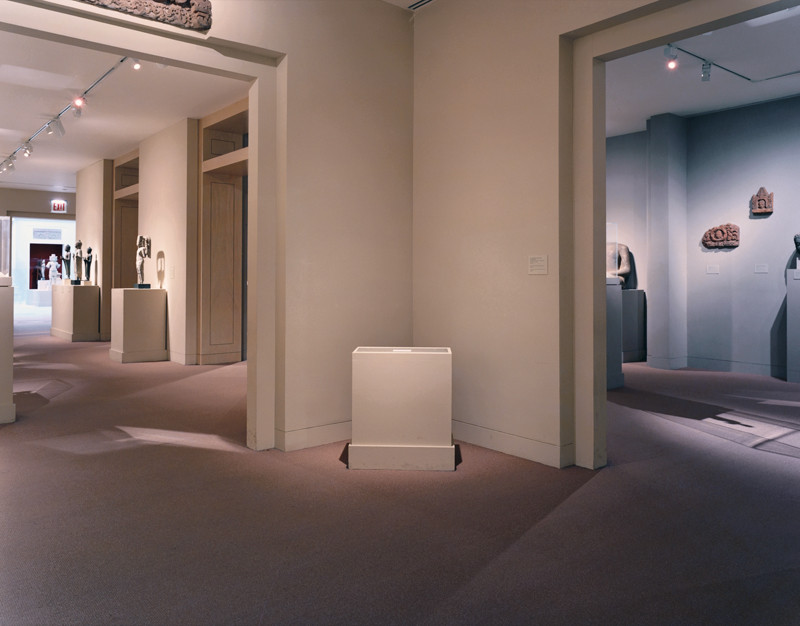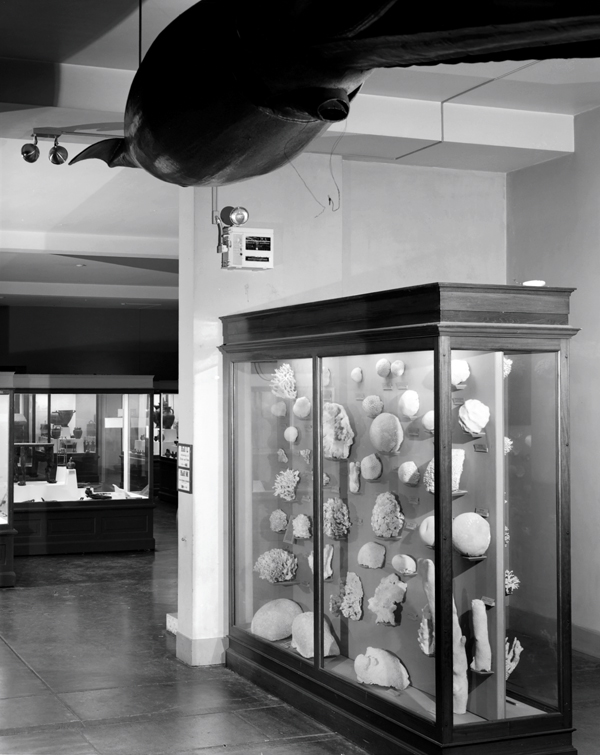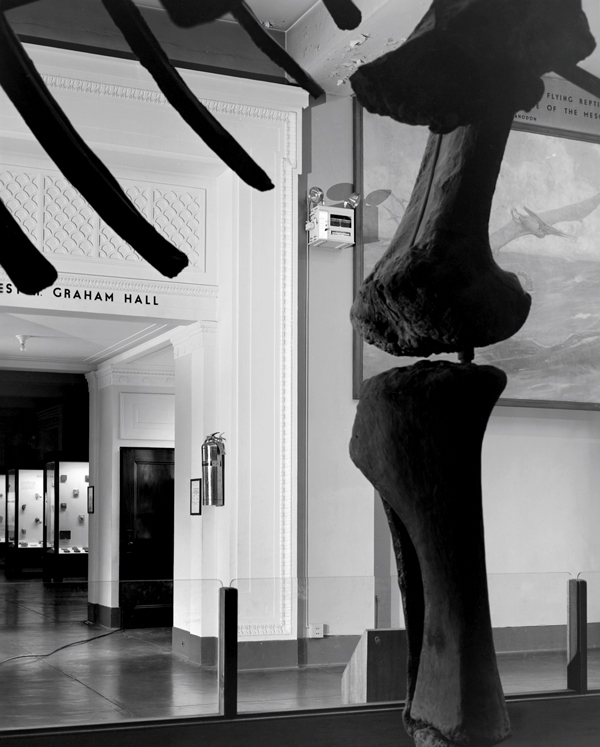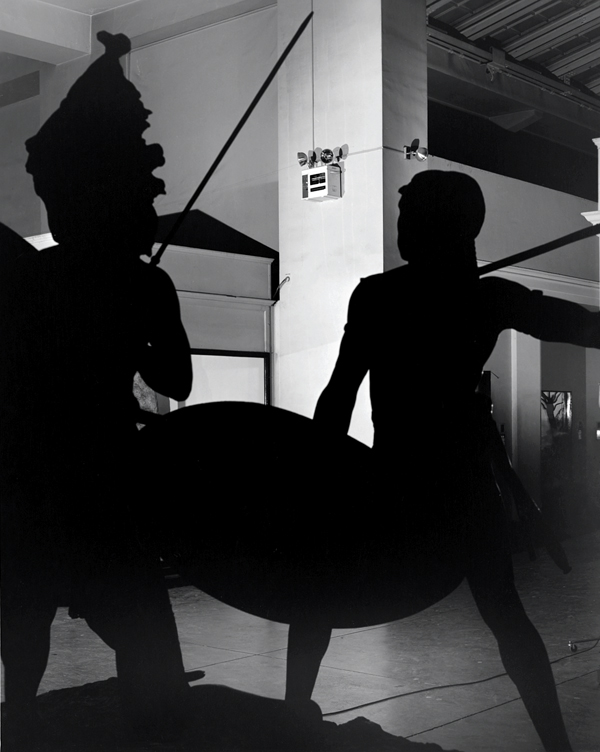[Fall 2002]
Ingelevics capitalizes on the dense detail of this photography, which often paradoxically obscures the intention or subject of the photograph. He turns his anomic gaze onto the signage and improvised spaces (security desks, temporary exhibitions, corridors) in the museum that are usually not noticed as the museum visitor moves toward what is imagined to be the main event.
In his current photographic projects, Vid Ingelevics draws attention to our cultural investment in the museum and the things that we assume it represents. As anomic flâneur, he has turned his ambiguous regard to things that we would ordinarily ignore on the way to an imagined main event1.
His work is not only an examination of what we ordinarily don’t choose to see, but also an inquiry into the functioning of museums, and, beyond that, into the uses of photography as a medium. Ingelevics’s starting point was curiosity about the work of museum photographers, whose work is situated somewhere between technical exercise – photographing works of art, documenting exhibition installations (small “a” art) – and “Art” and “Art History” (big “A” art). Taken with large-format cameras, archival museum photographs present an enthralling hypertrophy of detail. And yet, it is often difficult to know what the intended subject of any given museum photograph was. Signage? Exhibition installation? Traffic pattern? A proposed renovation? These images effectively equalize all the information that they contain. Their subject is camouflaged by the very proliferation of detail in the overall field in which it lies.
Ingelevics’s work engages, often with mild irony, with our theoretically informed expectations. In some sense he makes Barthes’s punctum into the subject of these images. Infected by the deathly past tense of every photograph, the punctum is an accident (of a photographic detail), “which pricks me . . . bruises me, is poignant to me,” “a sting, a speck, a cut, a little hole,” a wound or “stigmatum,” a kind of vaccination against death. This punctum as detail can be twinned with Aby Warburg’s art-historical principle of the memory trace: a moment connected to or triggered by recognition, allied to our impulse to mimetically represent2. Warburg’s photograph as memory trace and mimetic impulse and Barthes’s punctum are all united in the suspension of forces that constitute the cliché: any foray into the realist photograph churns up the same theoretical material.
Ingelevics deliberately revisits André Malraux’s “Musée Imaginaire” (“Museum without Walls”), and the fact that “for the last hundred years . . . art history has been the history of what can be photographed.” The paradox in this, as Douglas Crimp pointed out, is that the photograph itself is uniquely qualified to serve as its own documentation – it is absolutely photogenic. It therefore occupies an odd terrain within the museum. Ingelevics’s earlier exhibition, Camera Obscured: Photographic Documentation and the Public Museum, is composed of photographs – of works of art, photographs of the photographers, archivists, guards and guard dogs – ordered from museum archives. In theory, anyone could buy any of the photographs from the relevant institutions and mount a similar exhibition. The exhibition therefore raises the problem of its own definition as an exhibition. Is it art or archive or social anthropological study or artist’s intervention?
The Between art and Art project turns on a vacancy at the core of the museum: a nagging sense of not being really certain what the issues or objects of spaces constitute by way of a big story. We may want to pulverize grand narratives, but often, the trick is finding them. Ingelevics’s photographs are not information, not polemic, not institutional history, and not architectural meditation. They capitalize on juxtapositions of a kind that are usually clues to intelligibility and that we might expect to generate irony or enigma. But Ingelevics makes the things in his images seem generic: especially things that stand for “art” and “theory.” In one vast court at the Royal Ontario Museum, we see all at once (and from angles and distances that don’t give clues as to relative significance) a Buddha, a very “floristy” flower arrangement, a hanging sculpture, a security camera. This last component, the encounter of the photographer’s camera and the surveillance camera, signals with mild irony our contemporary historical preoccupation with the normative social operations of the visual (Lacan, Foucault, Barthes, as reactivated in Rosalind Krauss, Martin Jay, Jonathan Crary, and so on.)
The tone of these photographs skids between signalling the big meaning that we expect from museums and deliberate banality. While Ingelevics is in the territory of, say, Thomas Struth’s and Thomas Ruff’s jaded intensity in looking at the culture of looking at things, Ingelevics’s work relies less on deadpan intensity. He plays with the role of the mythic street photographer who is able to see astonishing conjunctions of people and things and details that the ordinary eye cannot (Brassaï, Frank, Winogrand, etc.). There is no doubt that his compositions signal this kind of virtuosic irony – the overlooked thing that is front and centre – but here this move is meant to draw out the dissatisfaction that might lie in such unexpected angles, rather than the unforeseen beauties or meanings that might be percolated from them.
Ingelevics ruthlessly isolates bathos. The word “Geology,” permanently carved in the stone above a gallery in the Royal Ontario Museum, marks off a gallery that doesn’t exist anymore, and it competes with a proliferation of temporary signs that seem much more at the heart of the museum’s business: “Druxy’s Delicatessen,” “ROM Reproduction Shop,” “Gift of the Gods,” and “Your Comments.” An important ornamental ironwork staircase from the Chicago stock exchange (now in the Metropolitan Museum) is a Benjaminian allusion to the ruins of nineteenth-century commerce. It is strangely deflated by the red fire extinguisher tucked into the corner below. (In fact, the fire extinguisher might be taken as a literalization of the expectations attached to an artist’s intervention in the museum.) Elsewhere, the grand rhetoric of architecture and exhibition installation abuts the odd ratty bits of office furniture for the museum’s security and information posts. The extraordinarily dense and even value of details in these photographs makes equivalent a speckled composite floor and a calligraphic poster; an empty Plexiglas brochure-holder and an elaborately carved stone monument; an orphaned Mondrian and a staircase railing.
Ingelevics plays with traditions of composition, centring and decentring, like a magician’s “force” that obliges us to choose between unsatisfactory alternatives. He raises the expectations that we attach to the museum (especially, lavish enfilade architecture and signage that points us in the right direction either through exhibitions or to the washrooms), and he isolates the incongruities in these expectations. He finds the labyrinth within the enfilade. A plinth displaying only a card explaining that the art object has been removed is centred in one image. Centrifugal galleries splay off to either side of the plinth, and we are at a loss as to what to see and which way to go. We effectively are given a choice, but without the information to make that choice.
In another photograph, the white expanse of a wall meeting the grid of panes of a ceiling skylight works like a theatrical illustration of vanishing-point perspective. This is counterweighted by an obstructed row of sculptures that barely rise above the bottom of the photograph. Funnily enough, the vanishing point for this dramatized spatial effect is an “Exit” sign. This might signal the debate about the symbolic meanings of the system of vanishing-point perspective and its broader perceptual and political implications as it has functioned through Western European culture into the present: from Alberti to Panofsky to Lacan to McLuhan to Damisch. The monocular viewer of Renaissance perspective systems, stationed in just the right spot to receive the perspective effect, must participate in the construction of the illusion: a suspect complicity with ideological structures, we know. But beyond its role as a vanishing point, here the “Exit” sign is a sport with the punctum, and a wry recognition that our theorizing of what we see falls back again and again into certain issues. Another “force”.
The rich surfaces of Ingelevics’s photos, like those of museum photographers, give the seductive message that we could blow up any detail indefinitely and see more and more of it and in it. This serves the rhetoric of museum architecture: as either traditional Beaux Arts marble or modernist white box, it is infinitely vast – as filled with significance as a tin can is filled with a vacuum – and durable. The passage through a museum is like an allegory: a peripatetic quest punctuated by strange and beautiful and deathly things and cryptic personifications. We encounter puzzles and riddles – what does the label or sign actually mean? Which way should we turn at this juncture? What happens if we pull the fire extinguisher out from under the stairs? Yet, passing through Ingelevics’s images, we suspect that there will be no deferred gratification or revelation at the end of our course. Museum visitors, passing through the camera’s long exposure time, are barely captured, and usually disappear. Only in one interior photograph, for which Ingelevics requested that the guards stand still, does human presence fully register. While this necessity of the long pose is a ghost of nineteenth-century daguerreotype effects, there is no nostalgia in Ingelevics’s work; nor does he capitalize on the prestige of the blurry appropriated image. His use of the large-format camera to record his museums is more like a neutron bomb: only inanimate things survive.
1 Such interim spaces are theorized in Marc Augé, Non-lieux: introduction à une anthropologie de la surmodernité (Paris: Seuil, 1992).
2 See Matthew Rampley, “From Symbol to Allegory: Aby Warburg’s Theory of Art,” Art Bulletin, 79 (1997): 61–77.
Vid Ingelevics is a Toronto artist, independent curator, and writer. Current and upcoming exhibitions can be seen at Gallery TPW, Gallery 44, and the Leonard & Bina Ellen Art Gallery. His curatorial project Camera Obscured: Photographic Documentation and the Public Museum will be shown in Germany in 2003. He has published reviews and essays in Canadian Art, C magazine, Blackflash, and others. He is represented by Stephen Bulger Gallery, Toronto.
Elizabeth Legge is an associate professor in the Fine Art Department at the University of Toronto. She has written on dada and surrealism, including a book, Max Ernst: The Psychoanalytic Sources. She has recently written on Vera Frenkel (Visual Culture and the Holocaust, ed. Barbie Zelizer, 2000), and contemporary British art (Representations, Summer 2000). Her current work on Michael Snow has been awarded an SSHRC research grant.


